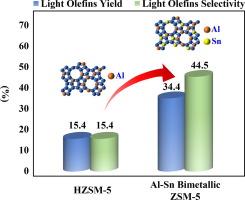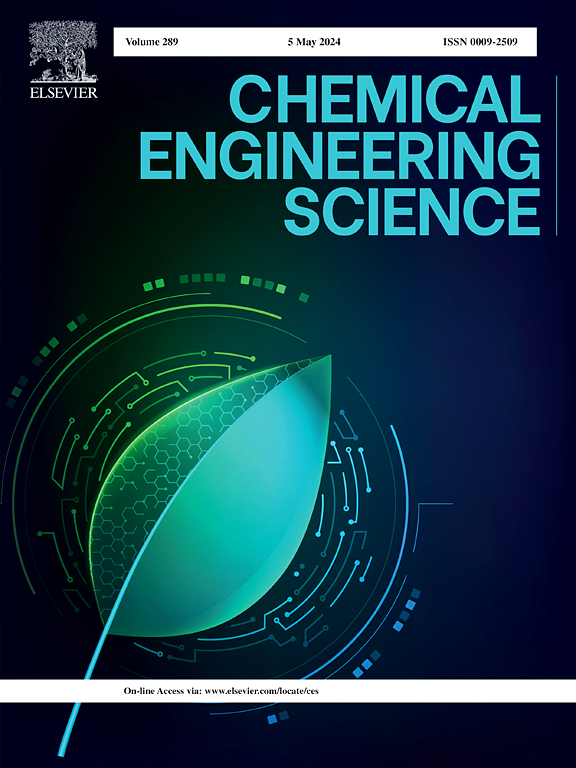铝锑双金属 ZSM-5:在裂解正己烷生产轻烯烃过程中的酸度调节和优异性能
IF 4.1
2区 工程技术
Q2 ENGINEERING, CHEMICAL
引用次数: 0
摘要
ZSM-5 沸石被广泛用于碳氢化合物裂解生成轻烯烃,其酸度与活性和产物分布密切相关。本研究采用 "一锅法 "制备了铝锡双金属 ZSM-5。XRD、UV-Vis、XPS 等表征结果表明,锡物种主要以四面体锡 (IV) 的形式嵌入沸石框架。此外,Sn 原子促进了路易斯酸位点的形成,减少了布氏酸的含量,从而有效抑制了副反应(如芳香化、氢转移)的发生,提高了正己烷裂解过程中轻烯烃的选择性。由于具有适当的酸性,HZ5[100,200](Si/Al = 100,Si/Sn = 200)的轻烯烃产率达到 33.4%,而含有 HZ5[50,∞](Si/Al = 50,Si/Sn=∞)的体系只有 15.4%。通过优化反应条件,HZ5[100,200]在 575 °C、WHSV 为 2 h-1 的条件下获得了更好的催化性能(正己烷转化率为 91.6 %,轻烯烃产率为 37.6 %)。本文章由计算机程序翻译,如有差异,请以英文原文为准。


Al-Sn bimetallic ZSM-5: Acidity regulation and excellent performance in cracking n-hexane for production of light olefins
ZSM-5 zeolite is extensively employed for hydrocarbons cracking to generate light olefins, and its acidity is closely related to the activity and product distribution. In this work, Al-Sn bimetallic ZSM-5 was prepared via a “one-pot” route. Characterizations, including XRD, UV–Vis, XPS, revealed that Sn species were mainly embedded into the zeolite framework as tetrahedral Sn (IV). Moreover, the Sn atoms promoted the formation of Lewis acid sites and reduced the Brønsted acid amount, which effectively inhibited occurrence of side reactions (e.g., aromatization, hydrogen transfer) and improved the selectivity of light olefins in n-hexane cracking. Light olefins yield over HZ5[100,200] (Si/Al = 100, Si/Sn = 200) reached 33.4% due to the appropriate acid property, in comparison with only 15.4% for HZ5[50,∞] (Si/Al = 50, Si/Sn = ∞) containing system. Through optimization of reaction conditions, better catalytic performance (n-hexane conversion of 91.6% and light olefins yield of 37.6%) was obtained over HZ5[100,200] under 575 °C with WHSV of 2 h−1.
求助全文
通过发布文献求助,成功后即可免费获取论文全文。
去求助
来源期刊

Chemical Engineering Science
工程技术-工程:化工
CiteScore
7.50
自引率
8.50%
发文量
1025
审稿时长
50 days
期刊介绍:
Chemical engineering enables the transformation of natural resources and energy into useful products for society. It draws on and applies natural sciences, mathematics and economics, and has developed fundamental engineering science that underpins the discipline.
Chemical Engineering Science (CES) has been publishing papers on the fundamentals of chemical engineering since 1951. CES is the platform where the most significant advances in the discipline have ever since been published. Chemical Engineering Science has accompanied and sustained chemical engineering through its development into the vibrant and broad scientific discipline it is today.
 求助内容:
求助内容: 应助结果提醒方式:
应助结果提醒方式:


